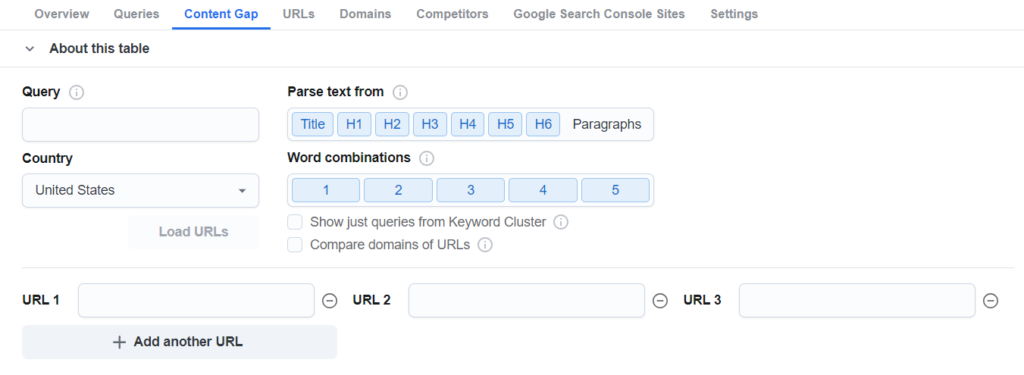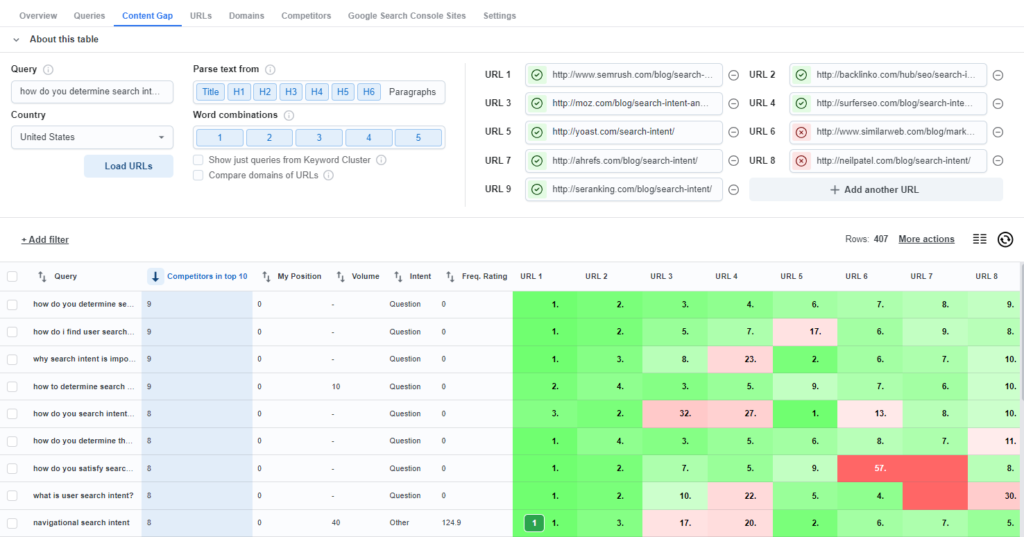SEO Content gap
URLsLab’s Content Gap feature helps you analyze competitors’ keywords and topics, identify gaps in your content, and enhance your SEO performance to drive targeted traffic.

Easily identify gaps in your content strategy by analyzing your competitors’ keywords and topics. Fill these gaps to enhance your SEO performance, improve user experience, outshine the competition, and drive targeted traffic to your website. Take your content strategy to the next level with URLslab’s intuitive content gap feature.
What is the content gap feature?
URLslab’s Content Gap feature analyzes keywords and topics that your competitors rank for, but you do not. This feature allows you to fill in these content gaps by creating new and relevant content to improve your SEO performance, enhance user experience, stay competitive, and drive targeted traffic.
How it works?
The content gap report detects overlapping SERP (Search Engine Results Page) queries in a provided list of URLs or domains, with a maximum allowance of 15 URLs.

Text parsing
You can choose where you parse the text from. Selecting this option will extract text elements from the designated URLs and compare them for phrase matching.
Enabling this feature will focus on parsing text exclusively from headers, such as H1 to H5 tags and title tags.
Using headings as a primary means of assessing keyword frequency is beneficial as copywriters often place keywords in titles and headings.
Word combinations
For search queries, the “n-grams” field determines how many words can be combined to form a complex keyword.
For example, a 1-gram (unigram) comprises a single word like “apple,” while a 2-gram (bigram) combines two words like “fresh apple,” and so on.
You can choose to have the plugin display only queries from the keyword cluster. Based on the entered query, all other best-matching keywords from the cluster will be identified. This option excludes keywords from the table that are present on the page but not reflected in SERP data.
Compare domains and URLs
nother vital thing to do is to compare domains of URLs. From given URLs, the domain name is extracted, and all queries where the given domain ranks in top positions on Google are compared. Evaluated are just processed queries, the more queries you process, the better results you get (e.g. 10k queries recommended).
For example, if this feature discovers another URL from the same domain ranks higher for a particular query, it will display it.
This process could help you identify other URLs within the domain that perform better than the selected URL. This information could be helpful if you are building content clusters to identify duplicate pages with the same intent or new opportunities found in competitor websites.
Note: If you select this option, computation will take much longer as significantly more queries need to be considered.
What are the benefits of URLsLab’s content gap feature?
- It allows you to stay competitive: Keeping up with your competitors and understanding their content strategy is crucial. The content gap feature helps you stay competitive by highlighting areas where you are falling behind and where you can outperform your competition.
- It helps improve your SEO performance: By identifying content gaps, you can create new and relevant content that targets those keywords and topics, ultimately improving your SEO performance and helping you to rank higher in search engine results pages.
- It aids in driving targeted traffic: By creating content to fill in the identified gaps, you can attract more targeted traffic to your website. This leads to higher-quality leads and a higher likelihood of converting those leads into customers.
How to test the content gap feature?
Suppose you browse queries and find some that are relevant. In the section “queries,” you click on the “Content Gap” placed by each query, and you will be instantly redirected to the Content gap section.

Now you see the position of each URL from the cluster at which individual queries are ranked. If there is no number in a row below the URL, it means that the URL is not ranking to that query at all.
In simpler terms, the more green results linked to your URL, the better your content is perceived. A higher number of positive green indicators highlights the effectiveness and appeal of the content you’re producing.
If you do not find some URLs relevant, you can easily remove them to have the best results possible. And vice versa; if you are missing some of, for example, your competitor’s relevant URL, you can add it by clicking on “Add another URL”.
Our tip: choose Sort by competitors in the top 10. It will give you the most relevant queries for your content optimization.
Tips to use the content gap feature
- Use various columns: Like in most of the URLsLab’s SEO plugin features, so also here are many options in the columns section. You can see key information of queries, such a competition index, intern, volume, low/high bid, and many more. The more columns you choose to display in the content gap feature, the more complex the overview of the queries cluster you get.
- Export data in CSV: If you want to keep this important data for future reference, for reporting or for any other reason, export the data to your device in CSV format. More actions → Export CSV.
- Utilize filters: These filters help you sort through large volumes of data quickly, focusing on specific areas of interest. For instance, you can filter keywords based on their search volume, competition index, or SERP position. This allows you to prioritize your content strategy and better target keywords that can yield high returns.
Frequently asked questions
- What is the Content Gap feature?
URLsLab's Content Gap feature analyzes keywords and topics that your competitors rank for, but you do not. It helps you fill these gaps by creating new content, improving SEO performance, enhancing user experience, and driving targeted traffic.
- How does the Content Gap feature work?
The feature detects overlapping SERP queries among up to 15 URLs or domains, identifies missing keywords and topics, and highlights areas where your content strategy can improve to outperform competitors.
- What are the benefits of using the Content Gap feature?
It helps you stay competitive, improve SEO performance, and drive targeted traffic by highlighting areas where you can create new and relevant content that your competitors are already ranking for.
- Can I compare domains and URLs with the Content Gap feature?
Yes, you can compare domains and URLs to discover which pages or domains perform better for specific queries, identify duplicate pages, and uncover new content opportunities.
- How can I test the Content Gap feature?
Browse relevant queries, click on 'Content Gap' next to each query to see ranking positions, add or remove URLs as needed, and use sorting options for the most relevant optimization opportunities.
Boost Your SEO with Content Gap Analysis
Start identifying missed opportunities and optimize your content strategy with URLsLab’s powerful Content Gap feature.



